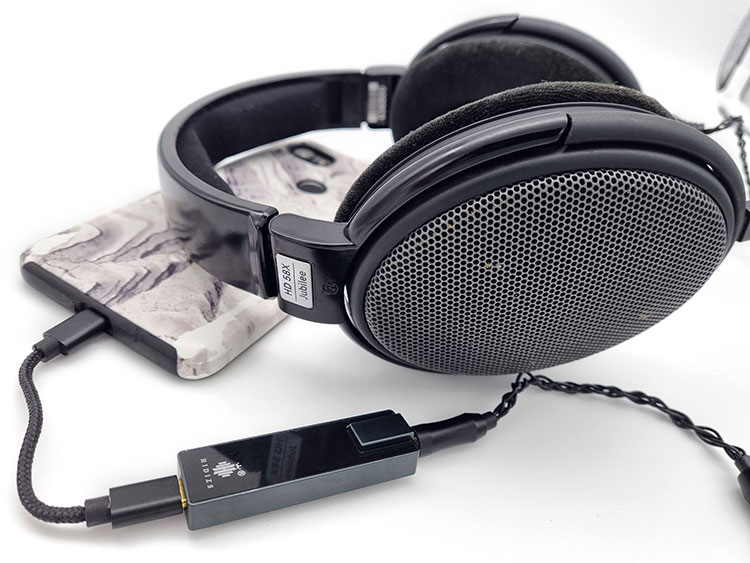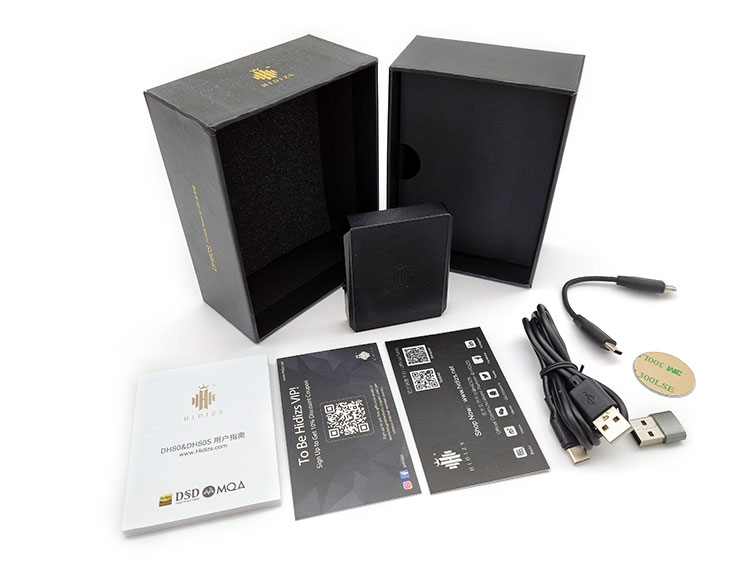Synergy
Power
As mentioned earlier, the 3.5mm SE output produces 125mw per channel, and the 4.4mm balanced output provides 210mw per channel. Admittedly, it isn’t the most gargantuan source of power, but what it lacks in aplomb, makes up for qualitative improvements.
Given its pocketable size, one shouldn’t expect the DH80s to power highly inefficient headphones such as the notorious Fostex T50RP. However, it does serve as a wonderful option for new audiophiles testing the waters with affordable, 4.4mm balanced connections; a gateway drug that would still serve a purpose down the line.
Pairings
In this section, the DH80S will be paired with multiple IEMs in ascending order of mechanical impedance and insensitivity, starting with the Moondrop Variations.
The Variations are a reasonably efficient pair of IEMs at 15.2 Ohms and 118dB/Vrms. As expected, the DH80’s 4.4mm balanced output provides copious amounts of power beyond what is necessary.
The Variations’ lateral field is much larger, with precise separation between each sonic element Furthermore, the Variations’ already-rotund bass response is complemented by the DH80s sonic profile.
Jumping to a less efficient IEM, the Kinera Nanna is rated at 60 Ohms, and has a 110dB/mW sensitivity. Thankfully, its nominal impedance and lowered sensitivity do not seem to be a problem on the DH80s. Granted, its internal volume control had to be increased by 4-5 steps, but there was still plenty of room for further volume increases.
Audibly, the Nanna’s shimmery treble occasionally comes across as artificial or synthetic. The DH80S managed to inject dynamism by boosting the low-end and masking some of the not-so-pleasant qualities in the midrange. Consequently, the Nanna’s signature treble is disproportionately veiled, masking some of the qualities that the Nanna is known for.
The final pairing, the Tin Hifi P2+, is a notoriously difficult IEM to drive; even on full-sized desktop amplifiers, one must turn the volume pot to the noon position; driving this IEM is no easy feat.
Unsurprisingly, the DH80S struggles to funnel enough power into its current-hungry planar transducers. The upper-mids to highs sound incredibly veiled, the P2+’s mid-bass punch sounds flabby and unrestrained.
To surmise, this is not a workable pairing. Given the P2+’s unconventional design, the DH80S still deserves some commendation for a valiant effort, albeit an unsuccessful one.
Select Comparisons
Periodic Audio Nickel
$299 USD
Technical
The Periodic Audio Nickel is an “old-school meets new-school” portable amplifier. Instead of incorporating a modern USB connection, this novel device sticks to the tried-and-tested 3.5mm unbalanced line-in.
The biggest drawback of such a design is the signal coming out of one’s source would not be a fixed line-out. Ingeniously, the Nickel sidesteps those issues by having a huge resistor to avoid double amplification. At 250mW of power output into 32ohms, the Nickel is a worthy contender against the DH80S.
Design
The Nickel is a non-descript, polycarbonate brick with petite dimensions, at 80mm x 30mm x 18mm. Weighing in at just 20grams, this is a highly pocketable solution for grab-and-go users.
At the bottom of the chassis, there are 3 sections: the output, an LED indicator, and the input. Each port is appropriately marked to differentiate them from one another. The micro-USB port is located at the opposite end of the unit.
Operating the device is incredibly simple: if the 3.5mm input is connected, the device powers on as signaled by the LED indicator. Each color corresponds to the amount of charge the Nickel is currently carrying green= full or close to full power, yellow= half-full, red= running out of charge.
In comparison to the DH80S, the Nickel feels less durable under its plastic build, and its featherlight weight. Moreover, users are expected to carry their own dongle DAC to connect it to smartphones with no 3.5mm aux.
More importantly, there are no balanced outputs for audiophiles tempted to test the waters of the 2.5mm/4.4mm balanced world. But, if you’re looking for a solution that takes up far less real estate and a no-frills approach to amplification, the Nickel is one to look out for.
Performance
Objectively, the Nickel outputs more power by 45 mW into 32 Ohms as compared to the DH80S’ 4.4mm balanced output. Nevertheless, both units are exemplary amplifiers that achieve similar goals, and in fact, similar sound signatures.
On the Moondrop Variations, both units achieve a strong damping factor by exerting more power and control over the LCP diaphragm, noticeably tightening the low-end. Mid-range and high details sound more prominent, and less congested on either unit.
Comparatively, the nickel slightly edges out the competition by emphasizing the perceived distances between audible cues in more complex passages. The nuances in terms of spatial imaging are more pronounced on the Nickel. However, the DH80S is no slouch, and these differences are too minute for the Nickel to be identified as the superior winner.
Hidizs S9 Pro
$299 USD
Technical
The S9 Pro does not have an independent battery, but it is an interesting comparison, nevertheless. The S9 Pro has been making waves recently for being a highly optimized portable DAC/Amp with exemplary measurements.
Under the hood, the S9 Pro houses an ESS ES9038Q2M, with 200mW into a 32-ohm load in the 2.5mm balanced output, and 100mW into a 32-ohm load in the 3.5mm unbalanced out; impressive measurements for an ultra-portable dongle.
Design
Aesthetically, the Hidizs S9 pro features a simple, oblong dongle with a “t-shaped” cross-section housing the 2.5mm balanced output, and the 3.5mm unbalanced output below. On the opposite end, the S9 Pro has adopted a standard USB-C input that draws but power and data from the playback source.
Moreover, the Hidizs Logo on the S9 Pro doubles down as an LED indicator that represents the bitrate of the song files being sampled: Yellow= DSD64/128, Purple= DSD256/512, Blue= PCM176.4/192(Khz), Red= PCM 352.8/384(Khz), Red= PCM 352.8/384(Khz), White= PCM 705.6/768(Khz), Green= PCM 44.1/48/88.2/96(Khz)
Design-wise, the differences could not be more obvious from a features perspective. The S9 Pro is the convenient option that draws power from the playback device; there is no need to charge a separate device for music playback.
Additionally, the S9 Pro adopts the 2.5mm balanced standard vis-à-vis the newly minted 4.4mm balanced option. If charging an additional device or carrying 2.5mm to 4.4mm convertors is too much of a hassle, the S9 Pro is arguably the better option.
Performance
Again, the S9 Pro marginally lacks the power output of the DH80S on both balanced and unbalanced outputs. But how does that translate into real-world sonic performance? The results are somewhat interesting.
The S9 Pro’s distinct house sound is slightly more clinical, emphasizing the grainier details in the treble, alongside instruments and vocals with characteristic upper-mid ranges. Lateral width is above-average, and imaging or separability between instruments/vocals is subtly enhanced.
Conversely, the DH80s adds a slightly neutral-to-warm veil whilst maintaining the technical capabilities of a more neutral sound profile.
However, the biggest differentiator is the DH80S superb spatial width and imaging. Complex passages and violent crescendos are given more elbow room to breathe. In the defense of the S9 Pro, this isn’t the fairest comparison given the DH80S’ independent power source. Nevertheless, a noteworthy effort by the widely revered S9 Pro.
Our Verdict
The DH80S is an excellent entry-level balanced DAC/Amplifier that offers tremendous value without breaking the bank. This is the version to get if you enjoyed the sound of the DH80s but don’t have an AP80 Series DAP to experience it.
To surmise, the DH80S is a creative expression of what portable amplifiers can achieve through ingenious design.
Hidizs DH80s Technical Specifications
- Hi-Res Audio Certified
- ESS9038Q2M DAC
- PCM: Up to 32bit768kHz
- Native DSD Supports Up to 512
- Single-ended 3.5mm + Balanced 2.5mm
- One-Piece High-Density CNC Aluminum Body
- Sampling Rate Indicator Light
- Powerful Drive Ability. 200mW BAL / 100mW SE
- Compatible with Windows/Android/Mac OS/iOS/iPad OS System






